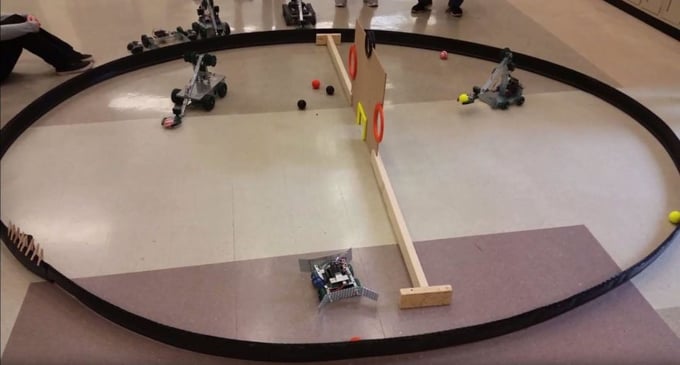Greg Geiger is a high school technical education teacher and curricular technology coach at Grayslake North High School in Grayslake, Illinois.
The end of the semester can be a hectic time for any classroom, and with the combination of athletics, activities, final projects, and final exams, students can be incredibly overwhelmed. However, this is also their time to show their teachers and classmates what they have learned.
For a few years now, we have been wanting a way to showcase what my Principles of Engineering (POE) students can do. We decided that once the class completed the kinematics unit, they would take the last two weeks of school and combine everything – simple machines, mechanisms, VEX control, and kinematics – and build a competition for the students. (Shout out to VEX EDR Competitions for some great competition ideas!) So now at the end of each year, my POE students create a remote-controlled robot to compete in a VEX EDR-style competition. It’s nothing as big as the VEX competitions, but it is something that keeps their attention during the spring semester, and it is something we do in full view of the school – in the hallways, the cafeteria, or the library.
Each year the competition is a little different, but the idea is always the same. It’s a combination of all of the construction and electronics knowledge put together to solve a new and exciting problem. This year we played a mixture of soccer, football, and basketball. The robots would be in an arena with a common target (goal) in the center; one scoring location was on the ground (soccer); one scoring location in the middle (football); and one scoring location on top (basketball). The robots would compete in this arena to score as many points as possible against an opponent in a set amount of time. Ideally each robot, or robots, would have the capability to score at all three levels, but that is easier said than done, and the point values for each “goal” are distributed accordingly. The groups were in a double-elimination bracket, and we spent three days competing for pride and a small 3-D printed trophy.
We try to keep the students guessing each year as to what sort of competition it will be, and VEX Competitions are often my inspiration, but we have taken ideas from students, other teachers, and even real-world scenarios.
It’s a simple idea; one that has certainly been tried elsewhere, but it is a favorite at our school and something the students look forward to all year. It also doesn’t hurt that the competition draws a lot of attention from passersby, and we have certainly picked up a little extra enrollment that way. We find it to be the highlight of the semester, and the students come back each year telling me how much they enjoyed it. From a curricular standpoint, it makes for an excellent summative assessment, because we can confidently assess most, if not all, of the VEX-based knowledge and skills, whether they are digital or physical.
PLTW’s blog is intended to serve as a forum for ideas and perspectives from across our network. The opinions expressed are those of each guest author.


